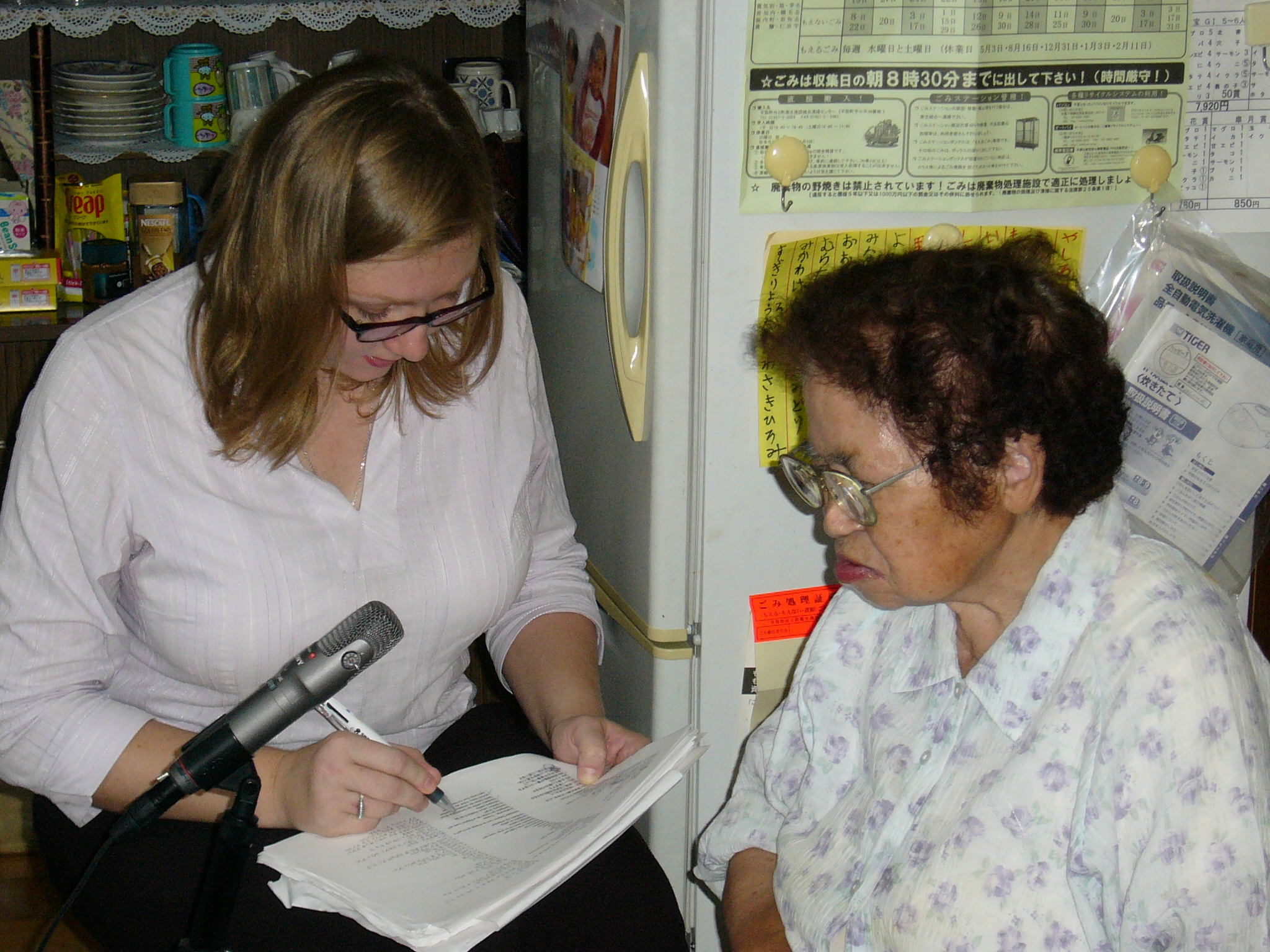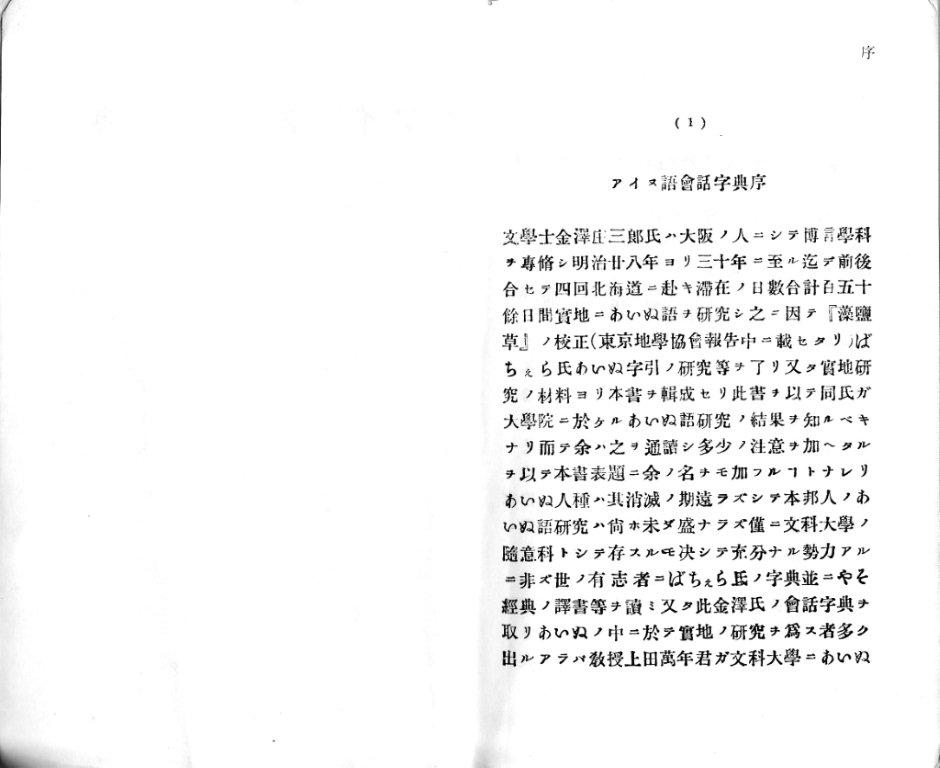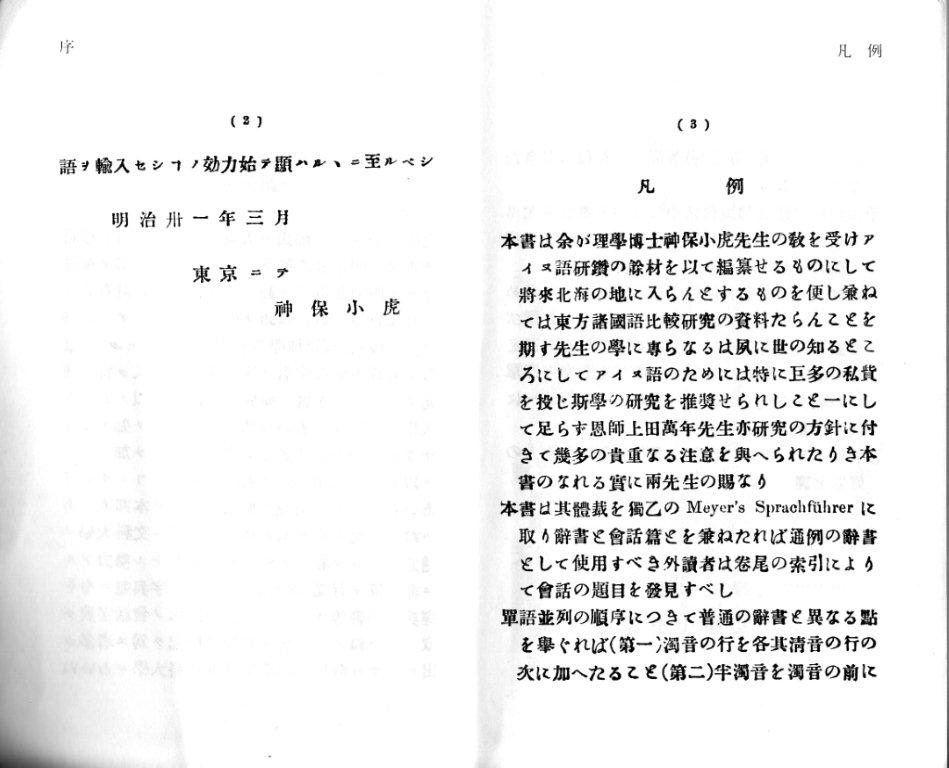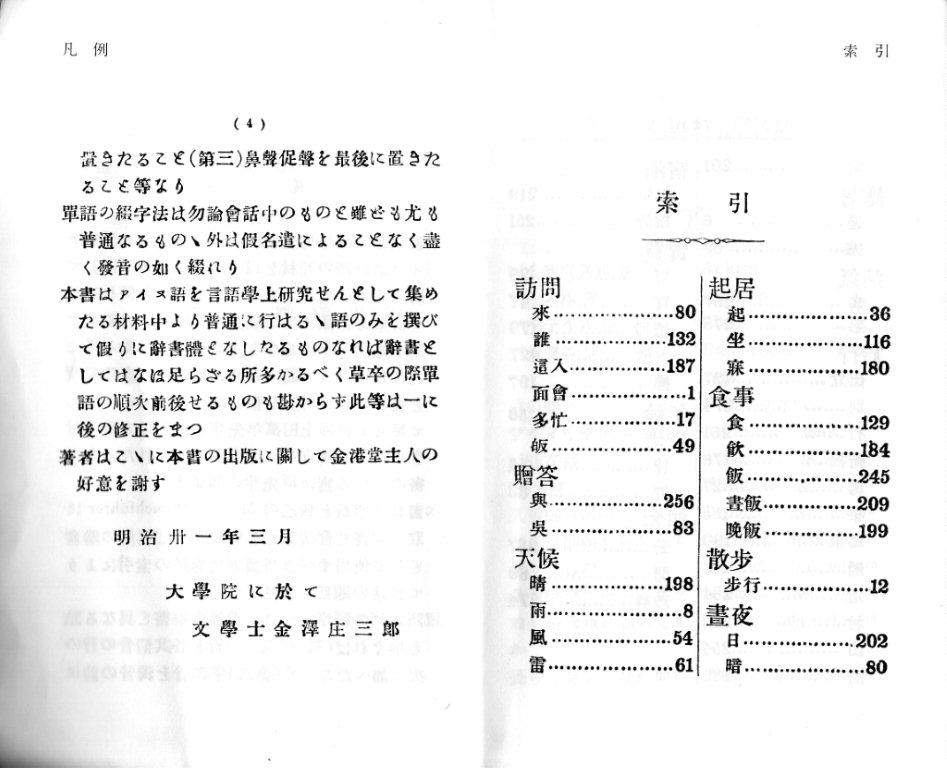■What is the Topical Dictionary of Conversational Ainu?
Recently, minority languages have been facing extinction on a global scale. According to a UNESCO publication from 2009, there are eight languages in Japan that are critically endangered, and the Ainu language tops the list with the highest degree of endangerment.
The genetic affiliation of Ainu is unknown; at present it is classified as a language isolate. Ever since the Ainu were recognized as an indigenous people in 2008, much attention has been paid to the revival of the Ainu language and culture. The necessity for education and research for this revival has also been a focus.
Most resources on the Ainu language are folklore, and unfortunately, there are few materials that can be used to study Ainu for ordinary conversation. In 2010, Bugaeva (et al) released the "A Talking Dictionary of Ainu: A New Version of Kanazawa's Ainu Conversational dictionary" (https://www.elararchive.org/dk0143/) on the University of London's website.

These contents are based on the original Ainugo kaiwa jiten (Ainu conversational dictionary) by Kotora Jinbo and Shōzaburō Kanazawa, first published in 1898 (reproduced in 1973, and republished in 1986 by Hokkaido Kikaku Center). In addition to the original notations, various information that can aid learning the Ainu language including the colloquial translation, Modernized Roman character transcriptions and katakana transcriptions of the Ainu word, interpretation (glossary) and English translation, etc., are provided. With the help of Setsu Kurokawa, a native speaker of the Saru Dialect of Ainu (Nukibetsu), we were able to upload audio of the Ainu language onto the web. We received many responses and comments from students and researchers regarding these contents. However, we were faced with budgetary restrictions when building the dictionary, and some technical problems remained.
With the cooperation of the Lago LWP (Director: Shirō Akasegawa), we have added a topic search (Japanese/English) and headword (Ainu, Japanese, English) search function to the above contents. We have also added photos of animals, plants, and tools (72 headwords, 86 photos) in this new version of the dictionary.
The original dictionary by Kotora Jinbo and Shōzaburō Kanazawa contained mistakes, misheard words, and even broken phrases (expressions that are inconceivable with original Ainu grammar). We deleted all questionable words and examples, items that were extremely different from Setsu Kurokawa’s audio, and words that Setsu Kurokawa was unfamiliar with. Double entries were basically consolidated to one entry. However, since the video data and audio data were recorded separately, there are cases where the Ainu expression is different in the video and audio. In those cases only, we decided that these were separate expressions, and listed both. In the end, we had 3467 headwords. For particularly rare words, we checked whether they were used in existing dictionaries, and added notes to them.
These changes were made so that students of Ainu could use these contents as learning materials. One must remember that Ms. Kurokawa used Japanese in her daily life for a long time, so her recordings are greatly affected by Japanese.
This online dictionary was created as part of the "Typological and Historical/Comparative Research on the languages of the Japanese Archipelago and its Environs" (project leader: John Whitman) and "Documentation and Transmission of Endangered Languages and Dialects in Japan" (project leader: Nobuko Kibe), NINJAL Collaborative Research Projects. Anna Bugaeva (NINJAL, associate professor) and Shiho Endō (Chiba University, PhD student; project collaborator) prepared the basic data from a linguistic perspective, and Lago Institute of Language (Shirō Akasegawa) built the online system.
We hope that students throughout the world will enjoy this journey through the Ainu language.
■Background on the original Ainu Conversational Dictionary
These contents are based on the original Ainugo kaiwa jiten [Ainu Conversational Dictionary] as it contains large amounts of data on conversations in Ainu.
The Ainugo kaiwa jiten is a dictionary prepared by Shōzaburō Kanazawa, and is a compilation of a “dictionary and conversation section”. Kanazawa visited Hokkaido to research the Ainu language between 1895 and 1897 while he was a postgraduate at Tokyo University. Professor Jinbo Kotora, a professor at Tokyo University, supervised Kanazawa's findings and added advice to the final dictionary.
In the “dictionary” section, words and phrases are arranged in the syllabary order of the Japanese language. The Ainu word corresponding to each is given in Roman characters. Categories such as “Visit” and “Exchange” are listed in the Table of Contents, and on the corresponding pages, phrases often used during a “Visit” or phrases related to “Exchange” are presented in a true conversational format.
Early researchers of the Ainu language treasured this "dictionary" as a document that summarized daily conversation. In “Remembering Professor Kyōsuke Kindaichi” (in Research on Ainu Place Names 4-volume book) by Hidezō Yamada, it says that when Kyōsuke Kindaichi, as a university student, went to Hokkaido for the first time to record the Ainu language, he used this dictionary intensively. The book that he used and in which he wrote many notes was lent out to his pupils, and other researchers including Hidezō Yamada, Mashiho Chiri, and Itsuhiko Kubodera all borrowed this dictionary and copied it.
▶English translation of preface by Sarah Rumme-Nishida
▶Preface and explanatory note images
Click the image to start the slideshow. Press the space key to display the next image. Press the ESC key to quit the slideshow.
■Dictionary Structure, Transcriptions and Explanatory Notes
▶Topics and subtopics
In the index of the original Ainugo kaiwa jiten, main words have been selected as the headwords, and each is then further grouped into several topics. These contents follow this method and have assigned a large group (“Topic”) and subgroup (“Subtopic”) to categorize each item.
The topics are groups that indicate types of items or contexts in which the words are used. A total of 63 topics have been set: “Ability”, “Action”, “Action of Hand”, “Ailment and Health”, “Animal ”, “Animal ”, “Behavior”, “Belief and Ritual”, “Boat and Fishing”, “Body”, “Change of State”, “Clothing”, “Conjunction”, “Day and Night”, “Debt and Credit”, “Demonstratives etc.”, “Direction”, “Division”, “Earth”, “Emotion”, “Entertainment”, “Excess and Deficiency”, “Exchange”, “Existence”, “Family”, “Fight”, “Fire”, “Food”, “Good and Bad”, “Greeting”, “Growth and Aging”, “House”, “Hunting”, “Knowledge and Psychology”, “Level and Amount”, “Life and Death”, “Likeness”, “Lodging”, “Movement”, “Name”, “Near and Far”, “Order”, “Particles etc.”, “Person”, “Place”, “Plant”, “Quantity”, “Question and Answer”, “Scenery”, “Seasons and Temperature”, “Senses”, “Shape and Size”, “Sky”, “Speed”, “State and Quality”, “Supposition”, “Time”, “Tool”, “Trade”, “Visit”, “Voice and Speech”, “Water”, “Weather”, “Wet and Dry”, “Work.”
The basic stance for categorizing the subtopics is as follows.
| (1) | The items (words) in bold for which there are examples (not indicated in bold in the original work) are set as the subtopic. However, there may be cases where the names have been changed slightly |
| (2) | For items in bold that lack examples, several items (words) having similar meanings are grouped and an appropriate subtopic is assigned. |
| (3) | As an exception, an item which falls under (1) but has few examples or of which the examples are all derivatives and not examples of usages were added in a subtopic having a name that differs from the original item name, as in (2). For verbs that have a transitive and intransitive, transitive verbs are included with the intransitive verbs unless there are many examples. |
▶Headword Body Structure
The following items are set for each headword (word or phrase). (The person in charge is shown in brackets)
| (1) | Japanese translation as in the Ainugo kaiwa jiten (original text used) |
| (2) | Ainu transcription in the Roman alphabet as in the Ainugo kaiwa jiten (original text used) |
| (3) | Ainu text by Setsu Kurokawa (Roman transcription); [Recording and transcribing: Bugaeva, confirmation and proofing: Endo] |
| (4) | Morpheme-to-morpheme interpretation (English) [Bugaeva] |
| (5) | Categorization of parts of speech (English) [Bugaeva] |
| (6) | English translation [Bugaeva] |
| (7) | Notes (English) on the peculiarities of grammar and phonetics of Setsu Kurokawa [Bugaeva, proofing: Endō] |
| (8) | Ainu language (katakana transcription) [Endō] |
| (9) | Word-to-word interpretation (Japanese) [Endō] |
| (10) | Categorization of parts of speech (Japanese) [Endō] |
| (11) | Modern Japanese translation [Endō] |
| (12) | Topic and subtopic categorization [Endō, proofing: Bugaeva] |
▶Notes on transcription
The transcription method in these contents basically follows that of Akor itak (1994). For Roman transcription, mainly the sixteen phonemes a, c, e, h, i, k, m, n, o, p, r, s, t, u, w, and y used by Tamura (1996) were applied. However, there are some questions regarding the phonological status of the glottal stop [ ’ ] so the glottal stop is indicated only when it occurs between a vowel and consonant, and is not indicated when it occurs at the head of the word or between vowels (e.g., #1047 irwak’utari ‘brothers’).
As special symbols, parentheses in the Ainu language section of both the katakana transcription and Roman transcription are used in the following manner.
| [ ] | Word or morpheme that is not actually uttered, but which is thought necessary in the Ainu grammar. |
| ( ) | Word or morpheme that is actually uttered, but which is through unnecessary in the Ainu grammar. |
| (?) | Words for which there are questions in the interpretation |
Typically, the accent in the Ainu language comes to the second syllable if the first syllable is an open syllable, and to the first syllable if the first syllable is a closed syllable. Accent marks are not indicated for words that follow this rule.
There are some words to which this rule does not apply. The accent is specially indicated for such words (e.g. #0191 rúra ‘to carry’).
References
- Hokkaido Utari Kyōkai (ed) 1994. Akor itak. Ainugo tekisuto 1 [Akor itak. Ainu text 1]. Hokkaido utari kyōkai Sapporo: Krūzu.
- Tamura, Suzuko. 1996. Ainugo Saru hōgen jiten [A dictionary of the Saru dialect of Ainu]. Tokyo: Sōfūkan.
▶List of parts of speech
- (ppx/psx) personal prefix / personal suffix
- (PF) prefix
- (n) noun
- (nl) locative noun
- (prn) pronoun
- (nmlz; comp) nominalizer, complementizer
- (prp.n) proper noun
- (vi) intransitive verb
- (vt) transitive verb
- (vc) complete verb
- (vd) ditransitive verb
- (aux) auxiliary
- (adv) adverb
- (adv.pp) adverbial particle;
- (dem) demonstrative
- (pp) postposition
- (adv.conj) adverbial conjunction
- (conj) conjunction
- (fin.prt) final particle
- (num) numeral
- (n.interr) interrogative noun
- (intj) interjection
▶List of abbreviations used in English glossary
- 1 / 2 / 3 = 1st /2nd / 3rd person
- Ø = zero-marked 3rd person
- = = inflectional boundary in the morphemic line
- - = derivational boundary in the morphemic line
- A = transitive subject
- Agent
- ADV = adverbial
- AO = applicative object
- APASS = antipassive
- APPL = applicative
- ARG = argument
- AUX = auxiliary verb
- CAUS = causative
- CLF = classifier
- COHR = cohortative
- COMP = complementizer
- COP = copula
- DIM = diminutive
- DESID = desiderative
- EMP = emphatic particle
- EP = epenthetic consonant
- EXC = exclusive
- EXCL = exclamatory particle
- FIN = final particle
- INC = inclusive
- INDF = indefinite
- INFR.EV = inferential evidential
- IMP.POL = imperative polite
- NEG = negative particle
- NONVIS.EV = nonvisual evidential
- NMLZ= nominalizer
- O = object
- PERF = perfect
- PL = plural
- POSS = possessive
- P.RED = partial reduplication
- RES = resultative
- Q = question particle
- REC = reciprocal
- REFL = reflexive
- REP.EV = reportive evidential
- S = intransitive subject
- SG = singular
- SGST = suggestive particle
- SOC = sociative
- sth = something
- TOP = topic
- VBLZ = verbalizer
- VIS.EV = visual evidential
▶ Dictionaries used in these contents
The following dictionaries were used as reference when editing the contents.
The following codes are used for quotations in these contents
| OO | Okuda, Osami. 1999. Ainugo shizunai hōgen bunmyaku-tsuki goi-shū (CD-ROM-tsuki) [Ainu Shizunai dialect lexicon in a context (with CD-ROM)]. Sapporo: Sapporo Gakuin University. |
| KAY | Kayano, Shigeru. 1996. Kayano Shigeru no ainugo jiten [A dictionary of Shigeru Kayano’s Ainu]. Tokyo: Sanseidō. |
| KUB | Kubodera, Itsuhiko. 1992. Ainugo-nihongo jiten: Kubodera Itsuhiko ainugo shūroku nōto chōsa hōkokusho [An Ainu-Japanese dictionary: A report on Itsuhiko Kubodera’s Ainu notes]. Sapporo: Hokkaido kyōiku iinkai Hokkaido bunkazai hogokyōkai. Iwanami Shinsho. |
| TAM | Tamura, Suzuko. 1996. Ainugo Saru hōgen jiten [A dictionary of the Saru dialect of Ainu]. Tokyo: Sōfūkan. |
| CM1 | Chiri, Mashiho. (1953) 1975. Bunrui ainugo jiten. Shokubutsuhen, dōbutsuhen [A classified dictionary of Ainu. Plants and Animals]. Reprinted in Chiri Mashiho chosakushū bekkan 1, Tokyo: Heibonsha. |
| CM2 | Chiri, Mashiho. (1954) 1976. Bunrui ainugo jiten. Ningenhen [A classified dictionary of Ainu. Man]:Reprinted in Chiri Mashiho chosakushū bekkan 2, Tokyo: Heibonsha |
| CM | Chiri, Mashiho. (1956) 1984. Chimei ainugo shōjiten [A small dictionary of Ainu toponyms]. Sapporo: Hokkaido Kikaku Center. |
| NAK | Nakagawa, Hiroshi. 1995. Ainugo chitose hōgen jiten [A dictionary of the Chitose dialect of Ainu]. Tokyo: Sōfūkan. |
| HAT | Hattori, Shirō (ed.) (1964) An Ainu dialect dictionary. Tokyo: Iwanami Shoten. |
| BAT | Batchelor, John. (1938) 1995. An Ainu-English-Japanese dictionary. Tokyo: Iwanami Shoten. |
■Background on Sestu Kurokawa and the audio and video data
The audio and video material was taped over a two-month period in August of 2008 and 2009 when Anna Bugaeva visited Setsu Kurokawa (Nukibetsu, Biratori-chō, Hidaka-kannai). Three additional short visits were made in September and November of 2009 and February of 2010.
 When Setsu Kurokawa (January 5, 1926 - January 21, 2015) was a child in the late 1920’s, many Ainu families had already stopped speaking Ainu at home. Considering this, Setsu Kurokawa’s proficiency in Ainu is relatively high. This can be explained by the fact that she was often taken care of by her grandfather and grandmother.
When Setsu Kurokawa (January 5, 1926 - January 21, 2015) was a child in the late 1920’s, many Ainu families had already stopped speaking Ainu at home. Considering this, Setsu Kurokawa’s proficiency in Ainu is relatively high. This can be explained by the fact that she was often taken care of by her grandfather and grandmother.
However, since Ainu is not used currently in everyday life, it was difficult to record the spontaneous utterances of the language. In the audio material in these contents, the words and expressions are not the spontaneous utterances of Setsu Kurokawa, but instead are audio data initiated based on the Ainugo kaiwa jiten. In the actual recording process, Anna Bugaeva read the words and expressions in the Ainugo kaiwa jiten, and Setsu Kurokawa repeated these in her own manner. The Ainu language expressions in this audio material are based on the Ainugo kaiwa jiten, and do not completely match Setsu Kurokawa’s idiolect.
▶Characteristics of Setsu Kurokawa's pronunciation

There are cases where the following pronunciation characteristics are heard due to Setsu Kurokawa’s own pronunciation traits and due to the fact that she was asked to pronounce the words slowly and clearly. Hence, there may be cases when the pronunciation is not exactly the same as the Ainu word in the headword.
A note is provided when the pronunciation is not exactly the same as the text. Please refer to the English note for each respective item for more details.
- ye at the end of the word is often pronounced as ie or iye.
- ye in the middle of the word or at the end of the word is often pronounced as e.
- kt is pronounced as tt in some cases
- tn is pronounced as kt in some cases.
- In typical Ainu language, plosive stops such as p, t and k in the syllable-final position should be realized as unreleased stops [p̚ ], [t̚ ], [k̚ ], i.e. without the air release stage, but in Mrs. Kurokawa’s case, these stops often sound like regular (released) stops [p], [t], [k] or as aspirated stops [ph], [th], [kh]. This is common in words that are pronounced slowly.
- When an a vowel occurs twice in a sequence, such as a’a, the glottal stop [ ’ ] cannot be heard clearly, and it sounds like [aa].
- The vowel u often sounds like o. (Note that this is also a typical characteristic of the Ainu language, but is especially apparent in Setsu Kurokawa’s pronunciation.)
■Acknowledgements
We are deeply grateful to Setsu Kurokawa who taught us about the Saru dialect of the Ainu language and helped with the recording of audio data. We are also grateful to Professor Hiroshi Nakagawa (Chiba University, Faculty of Letters) for his valuable instruction on the Ainu language.
We would also like to express special thanks to the following people (alphabetical order).
- Mika Fukazawa (checking audio files, adding notes on the accent)
- Kōichi Kaizawa, Miwako Kaizawa (photos)
- Masayoshi Kanzaki (introduction of the people of Nibutani Biratori-chō)
- Miki Kobayashi (checking video files)
- Serhii Korennov (audio and video material editing)
- Iku Nagasaki (advice on data processing, especially on using Toolbox software, various advice and support)
- Tetsuto Oono (confirmation of audio data, comments from the field of Ainu language teaching)
- Prashant Pardeshi (introduction of Shirō Akasegawa)
- Sarah Rumme-Nishida (English proofing, translation, topic/subtopic categorizing assistance)
- Maki Sekine, Kenji Sekine, Sachiki Izumino, Yuka Ozaki, and Hisao Oda (driving and assistance during recording)
- Itsuji Tangiku (advice on automatically converting Romanized Ainu words into katakana)
- Tomokazu Takada (translation of Ainugo kaiwa jiten preface)
- ToyToy (Motoi Ogawa) (creating Ainu pattern design for the interface)
- Yōhei Yamada, Kyōmi Yasuda (input of original book, checking)
- Alexey Zinov (Anna Bugaeva's husband) (driving, cooking and love during field trips)
- Ivan Zinov (Anna Bugaeva's eldest son), Nikita Zinov (Anna Bugaeva's second son) (encouragement and love during field trips)
We are also thankful to the students of the Ainu Language Class at the Ainu Culture Center (Tokyo) for evaluating the experimental multi-media piece Ainu Morning Talk (by Anna Bugaeva and David Nathan) which was the basis for this product,
To the people of Nibutani Biratori-chō for all their assistance and encouragement during the field research,
Finally,
To all the Ainu People from the past to present.
We are sincerely grateful that we had this opportunity to learn about their beautiful language and culture!
■Terms of Use
| 1. | This system supports Firefox, Chrome, Safari and IE (version 8 and above). We recommend that you use Firefox or Chrome in terms of processing speed. |
| 2. | When you write a paper or an article using A Topical Dictionary of Conversational Ainu, please cite as:
| National Institute for Japanese Language and Linguistics (2015). A Topical Dictionary of Conversational Ainu [Software]. Available from https://ainu.ninjal.ac.jp/topic/ |
|
■Update History
| 2015/1/26 | Japanese Version 1.00 |
| 2015/3/20 | Japanese/English Version 1.10 |
| 2018/8/1 | Japanese/English Version 1.11 |
■Contact
Please use the following contact form:
Contact Form(The form will open in a new tab)





 When Setsu Kurokawa (January 5, 1926 - January 21, 2015) was a child in the late 1920’s, many Ainu families had already stopped speaking Ainu at home. Considering this, Setsu Kurokawa’s proficiency in Ainu is relatively high. This can be explained by the fact that she was often taken care of by her grandfather and grandmother.
When Setsu Kurokawa (January 5, 1926 - January 21, 2015) was a child in the late 1920’s, many Ainu families had already stopped speaking Ainu at home. Considering this, Setsu Kurokawa’s proficiency in Ainu is relatively high. This can be explained by the fact that she was often taken care of by her grandfather and grandmother.